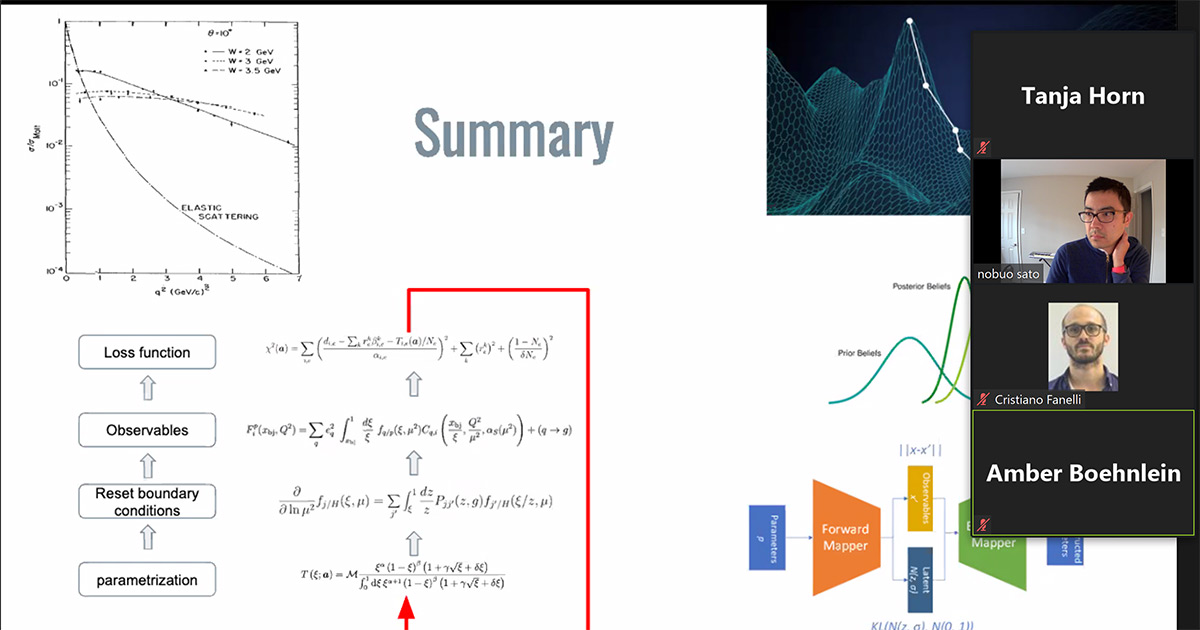

Artificial intelligence has the potential to transform the field of physics by speeding up data analysis and calculations as well as the design processes for new detectors, controls and calibration systems. These possibilities — and others — were explored during an Artificial Intelligence for Nuclear Physics (AI4NP) Winter School, hosted in January.
More than 300 students, researchers, and science enthusiasts from around the world signed up to participate in the weeklong series of virtual lectures and hands-on exercises that was co-hosted by The Catholic University of America, the Department of Energy’s Thomas Jefferson National Accelerator Facility (Jefferson Lab), and the University of Maryland.
Tanja Horn, a CatholicU physics professor who also works as a senior staff scientist at Jefferson Lab, was a co-organizer for the week. She said the program’s goal was to shed light on the many ways AI is already being used in the nuclear physics field and where it might be used in the future. Today many physicists are eager to use AI and machine learning to optimize their detector systems and data analytics.
“With rapid developments in the toolkits, it’s extremely important to have training and educational opportunities for people conducting basic research in nuclear physics, for simply maintaining up-to-date data skills, or for possibly applying and taking advantage of AI,” Horn said.
She hopes that the AI4NP school, which is envisioned to take place every two years, will be able to educate young scientists on the possibilities of using these new technologies.
“It’s difficult to overstate the importance of bringing young people, students, into this whole effort to create or to explore the new ideas that will be required for the progress of all of this field,” she said.
Prior to the COVID-19 pandemic, the organizers planned to max out enrollment for the winter school at 50 in-person participants. Once the event went virtual, enrollment exploded to 363 participants from five continents.
“It’s amazing, the response,” Horn said. “We saw some students who are computer science-focused but are interested in nuclear physics, but also the other way around. So, this is a very good combination, because it would represent that synergy we are hoping for with the school.”
The school was loosely organized over five days, with lectures and hands-on exercises touching on neural networks and deep learning, variational Monte Carlo and machine learning, data set feature extraction, and detector design optimization.
Lecturers for the week included physicists and research scientists from Davidson College in North Carolina, the Argonne National Laboratory in Illinois, the Massachusetts Institute of Technology, and Jefferson Lab. The AI4NP School was funded by the Department of Energy, Office of Science.
Vladimir Berdnikov is doing his postdoctoral research at CatholicU and said he is particularly interested in the design and performance of large scale subatomic particle detectors. He is eager to incorporate what he learned during the winter school for detector design optimizations.
“The school offered lectures and exercises with focus on application of AI to theoretical and experimental nuclear physics,” he said. “Such applications have complex requirements and go way beyond the features of a standard toolkit.”
"The Artificial Intelligence for Nuclear Physics Winter School was a terrific opportunity to learn, on a deeper level, about such an integral field of modern computer science,” said doctoral student Richard Trotta, who noted that nuclear physicists have often been slow to implement AI and machine learning techniques. “AI/machine learning takes an approach to problem-solving that is much different than what comes inherent to physics so it really was such a unique opportunity to explore problems from a completely different perspective. This school has given me a foundation and the tools required for use of these techniques in my own future research."